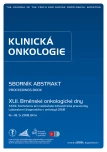MicroRNAs in Prediction of Response to Radiotherapy in Head and Neck Cancer Patients – Pilot Study
Authors:
P. Ahmad 1; M. Slavik 2; J. Šána 1; M. Hermanová 3; P. Šlampa 2
; P. Smilek 4; T. Kazda 1,2; O. Slabý 1
Authors‘ workplace:
CEITEC – Středoevropský technologický institut, MU, Brno
1; Klinika radiační onkologie LF MU a Masarykův onkologický ústav, Brno
2; I. patologicko-anatomický ústav, LF MU a FN u sv. Anny v Brně
3; Klinika otorinolaryngologie a chirurgie hlavy a krku LF MU a FN u sv. Anny v Brně
4
Published in:
Klin Onkol 2018; 31(Supplementum1): 137-139
Category:
Article
Overview
Background:
Radiotherapy plays a key role in the treatment of squamous cell head and neck cancers (HNSCC). The effectivity of radiation therapy is often limited by radioresistance of these tumours. microRNAs (miRNAs) are endogenous, evolutionary conserved, small non-coding RNAs involved in regulation of cellular processes associated with radioresistance. The objective of this study was to identify miRNA profile enabling to predict the radiation treatment outcomes in HNSCC patients.
Material and Methods:
The retrospective study included HNSCC patients who underwent a definitive radiotherapy. Patients were divided into two groups according to loco-regional control (LRC) as follows – short LRC (n = 22; median 5.1 months (min. 1.3, max, 18.6)) vs. long LRC (n = 21; 60.4 (min. 46.8, max. 98.8)) group. Global miRNA expression profiles were obtained by use of Affymetrix microarray technology (GeneChip miRNA 4.0 Array).
Results:
We identified 24 miRNAs to be significantly associated with LRC (p < 0.05), all of these miRNAs were upregulated in patients with short LRC. Out of these miRNAs, 12 miRNAs with p < 0.025 and 4 miRNAs with p < 0.01 have been identified.
Conclusion:
miRNAs seems to be promising as potential biomarkers predicting radiotherapy treatment outcomes in patients with HNSCC.
Key words:
microRNAs – radiotherapy – head and neck cancer
The authors declare they have no potential conflicts of interest concerning drugs, products, or services used in the study.
The Editorial Board declares that the manuscript met the ICMJE recommendation for biomedical papers.
Supported by Ministry of Health of the Czech Republic, grant No. 15-31627A. All rights reserved.
Submitted:
19. 3. 2018
Accepted:
20. 3. 2018
Sources
1. Gatta G, Botta L, Sánchez MJ et al. Prognoses and improvement for head and neck cancers diagnosed in Europe in early 2000s: The EUROCARE-5 population-based study. Eur J Cancer 2015; 51 (15): 2130–2143. doi: 10.1016/j.ejca.2015.07.043.
2. Dušek L, Mužík J, Uher M et al. Epidemiologie nádorů hlavy a krku. In: Šlampa P, Smilek P (eds). Nádory hlavy a krku. Praha: Mladá fronta 2016: 17–27.
3. Begg AC. Predicting recurrence after radiotherapy in head and neck cancer. Semin Radiat Oncol 2012; 22 (2): 108–118. doi: 10.1016/j.semradonc.2011.12.002.
4. Ahmad P, Sana J, Slavik M et al. microRNAs involvement in radioresistance of head and neck cancer. Dis Markers 2017; 2017: 8245345. doi: 10.1155/2017/8245 345.
5. Hess AK, Müer A, Mairinger FD et al. MiR-200b and miR-155 as predictive biomarkers for the efficacy of chemoradiation in locally advanced head and neck squamous cell carcinoma. Eur J Cancer 2017; 77: 3–12. doi: 10.1016/j.ejca.2017.02.018.
6. Chen L, Wen Y, Zhang J et al. Prediction of radiotherapy response with a 5-microRNA signature-based nomogram in head and neck squamous cell carcinoma. Cancer Med 2018; 7 (3): 726–735. doi: 10.1002/cam4.1369.
7. Kovarikova H, Bubancova I, Laco J et al. Deregulation of selected microRNAs in sinonasal carcinoma: Value of miR-21 as prognostic biomarker in sinonasal squamous cell carcinoma. Head Neck 2017; 39 (12): 2528–2536. doi: 10.1002/hed.24930.
Labels
Paediatric clinical oncology Paediatric radiology Surgery Clinical oncology RadiotherapyArticle was published in
Clinical Oncology

2018 Issue Supplementum1
- Metamizole vs. Tramadol in Postoperative Analgesia
- Metamizole at a Glance and in Practice – Effective Non-Opioid Analgesic for All Ages
- Possibilities of Using Metamizole in the Treatment of Acute Primary Headaches
- Current Insights into the Antispasmodic and Analgesic Effects of Metamizole on the Gastrointestinal Tract
- Spasmolytic Effect of Metamizole
Most read in this issue
- MicroRNA Analysis for Extramedullary Multiple Myeloma Relapse
- A Development and Overview of the Use of Chemotherapy and the Role of Radiotherapy and Surgery in Patients with Newly Diagnosed Pancreatic Tumor and Cancer in the Current 5-year Center Practice
- Flow Cytometric Analysis of Nucleoside Transporters Activity in Chemoresistant Prostate Cancer Model
- MicroRNAs in Prediction of Response to Radiotherapy in Head and Neck Cancer Patients – Pilot Study
